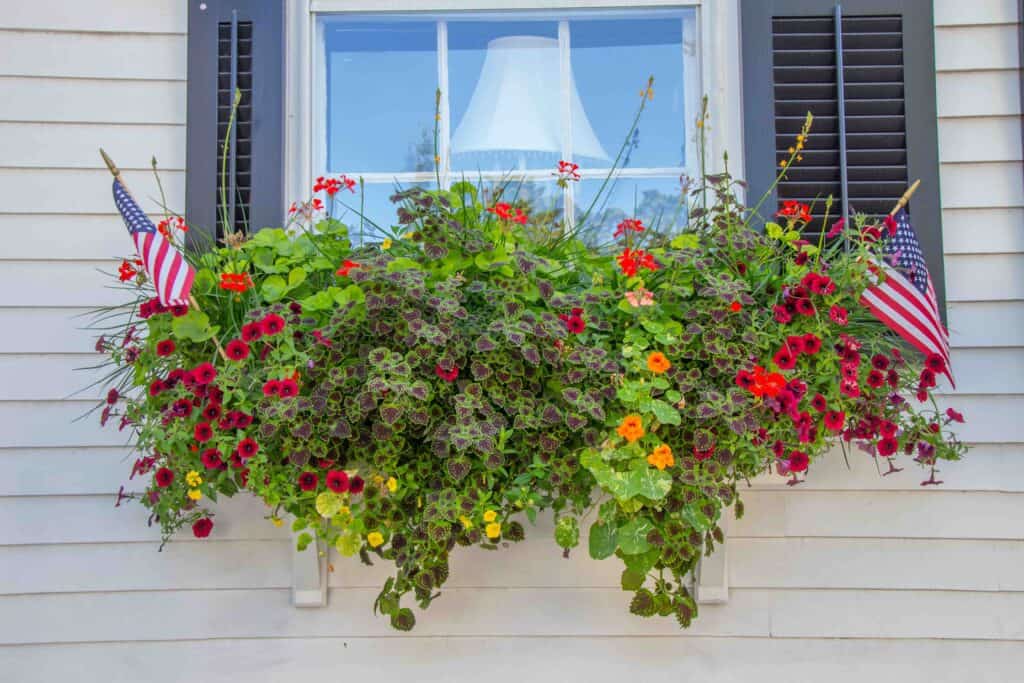Plant a window box this year and enjoy your tiny garden.
Window boxes are a delightful way to garden. They’re easy to install, simple to plant, and fun to care for. They don’t require endless hours of digging, bending and weeding to maintain. Best of all, window boxes make flowers and greenery a part of your home, growing in a place where you will see the plants often and enjoy them. If you’ve never gardened before, planting a window box or two will let you try your hand at growing plants on a small and very manageable scale. Mount window boxes on porch railings, windowsills, a garden shed or balcony.

Although most window boxes are more or less rectangular, your window box garden will look more natural if it contains plants of varying heights — taller plants in the back of the box, shorter plants in the middle, and low edging or trailing plants in the front to give the box a softer, less contrived look.
When planting window boxes, don’t line up your three sizes of plants in straight rows like little soldiers. For a more flowing, natural look, stagger the plants in the rows, placing some a bit farther back and others slightly forward. To bring visual movement to the box, vary plant heights from side to side across the box as well as front to back. Place taller plants at the back of the box, medium size plants in the middle ground, and smaller plants in the front. Including flowers that will spill over the front of the box adds charm.
Old-fashioned flowers and mixed color schemes bring a romantic look reminiscent of a cottage garden. Consider spicy-scented garden pinks, sweet William, johnny jump-ups, pansies, fuchsias, candytuft, nicotiana (flowering tobacco), cornflower, nasturtiums, calendula, primrose, French marigolds, Iceland poppy, and miniature roses.
For a romantic effect, you could include a flowering vine or two — morning glory or its night-blooming relative, moonflower, passionflowers, fragrant wisteria, honeysuckle, sweet peas or jasmine. Black-eyed Susan vine and canary creeper are other possibilities.
For a more formal look, design window boxes with plants neatly clipped and arranged in straight lines. A small evergreen centered in the back of the box adds height, and can be sheared in the shape of a neat cone or pyramid. Some plants for formal window boxes include dwarf boxwood, falsecypress (Chamaecyparis) and juniper. Upright flowering plants such as geraniums, tulips, daffodils, narcissus and impatiens also work well.

Window box containers should be at least 6 inches deep; 12 inches is even better. Wood is a classic material for window boxes; it’s a good insulator and protects plant roots from extreme temperatures better than plastic, clay or metal boxes.
Use an all-purpose potting mix, and check your boxes daily to see if they need watering. Regular watering is essential, as the small amount of soil in the boxes dries out quickly in summer weather. To keep the plants growing well, fertilize with an all-purpose liquid fertilizer beginning when the plants have been growing for several weeks. Follow the package directions.
Go over your window box plants regularly to pick off faded flowers and wilted leaves. Many-branched plants like impatiens need to be pinched back periodically to encourage bushier growth and lots of flowers. Then enjoy your tiny garden!














!['The Maples' is a prestigious generational compound of two extraordinary estates: 18 Maple and 22 Maple. This rare offering, designed by luxury architect Lissoni partners New York and developed by visionaries Alessandro Zampedri-CFF Real Estate and JK Living, redefines opulence with the highest quality of craftsmanship and captivating views of the Atlantic Ocean. Represented by @nycsilversurfer and @challahbackgirl of @douglaselliman. [link in bio]](https://hamptonsrealestateshowcase.com/wp-content/uploads/sb-instagram-feed-images/438891010_1083749139481747_7890082604579275354_nfull.jpg)
![Featuring 360-degree water views on Mecox Bay, the Atlantic Ocean and Channel Pond, 1025 Flying Point offers the ultimate beach cottage that is flooded with natural light. With panoramic views, proximity to the ocean, and a private walkway to Mecox bay for kayaking or paddle boarding, this truly is a special retreat. Represented by @ritcheyhowe.realestate and @hollyhodderhamptons of @sothebysrealty. [link in bio]](https://hamptonsrealestateshowcase.com/wp-content/uploads/sb-instagram-feed-images/438994305_737511778456166_4602476013493875279_nfull.jpg)
![Attention advertisers! 📣 Secure your spot in the highly anticipated Memorial Day edition #HRES. Reach thousands of potential clients and showcase your brand in one of the most sought-after publications in the Hamptons, NYC, Palm Beach, and beyond. Contact us now to reserve your ad space! [link in bio]](https://hamptonsrealestateshowcase.com/wp-content/uploads/sb-instagram-feed-images/438549843_275102939023235_6718257301437562124_nfull.jpg)
![You eat with your eyes, and on the East End, it’s important that what you eat looks just as good as how it tastes. At @rosies.amagansett, the restaurant itself is plenty photo-worthy with blue ceramic tiling and yellow and white striped fabric wallpaper. But for a dish that will light up your photos, head directly to the salmon tartare! [link in bio]](https://hamptonsrealestateshowcase.com/wp-content/uploads/sb-instagram-feed-images/437094269_7296727147115953_1594410326824303644_nfull.jpg)

![We were honored to be the media sponsor for @blackmountaincapital's open house event with @jameskpeyton and @jfrangeskos at 11 Dering Lane in East Hampton! Other sponsors included @landrover, Feline Vodka, @rustikcakestudio, @la_parmigiana, @lahaciendamexicangrill11968, @homesteadwindows, Stone Castle, @talobuilders, and @thecorcorangroup.
A big thank you Carrie Brudner of Black Mountain Capital for putting together this fabulous event! [link in bio]](https://hamptonsrealestateshowcase.com/wp-content/uploads/sb-instagram-feed-images/437081213_762912965932136_6847332836522786568_nfull.jpg)

![Blooms Galore at the Long Island Tulip Festival! 🌷✨ Mark your calendars for April 15th as the vibrant tulips at @waterdrinkerlongisland burst into full bloom! Enjoy a day filled with colorful splendor, food trucks, live music, and more. [link in bio]](https://hamptonsrealestateshowcase.com/wp-content/uploads/sb-instagram-feed-images/437083429_974242677583725_6855805712693638343_nfull.jpg)
